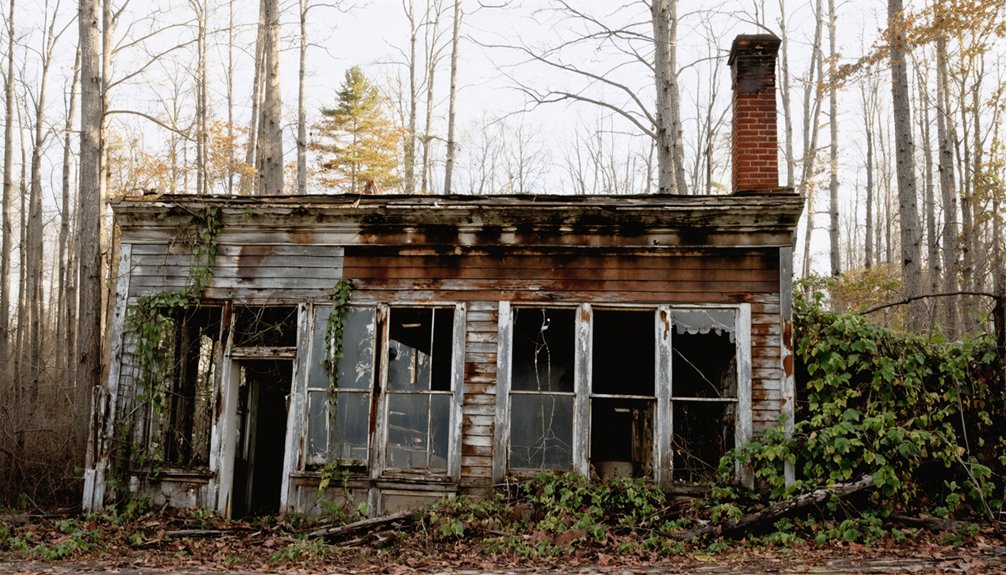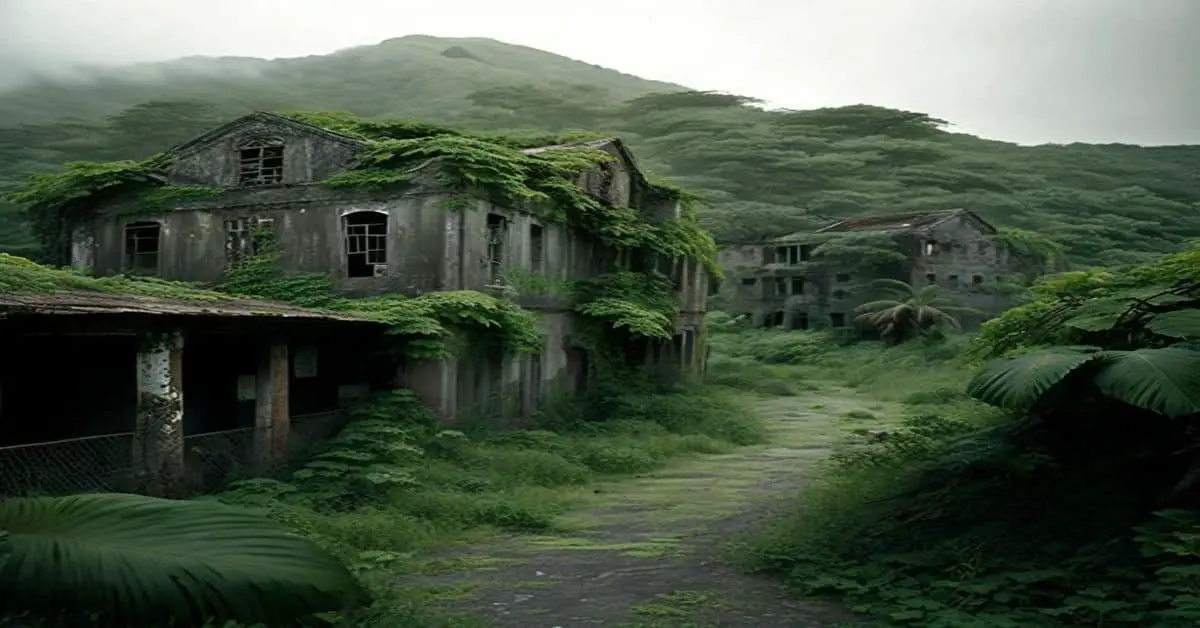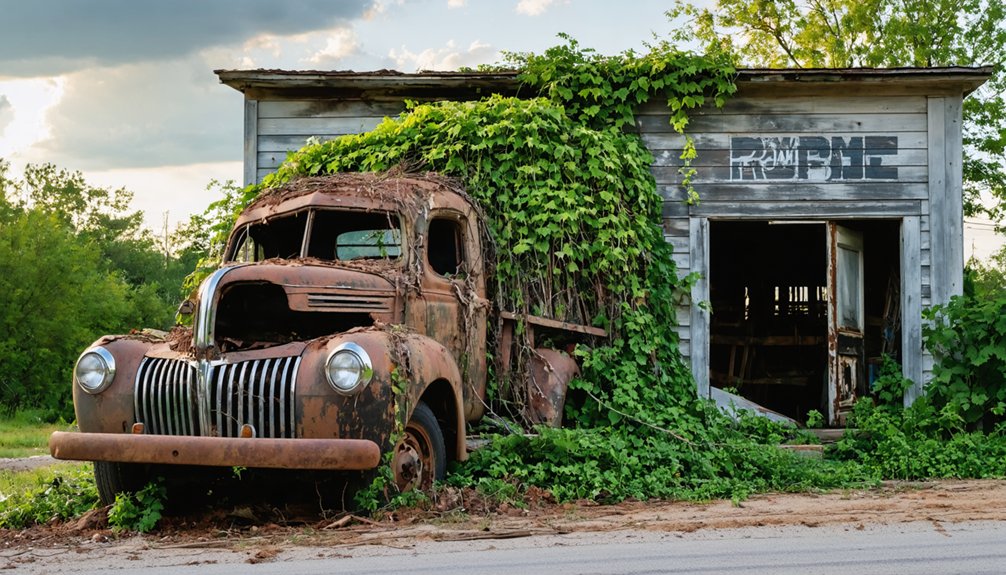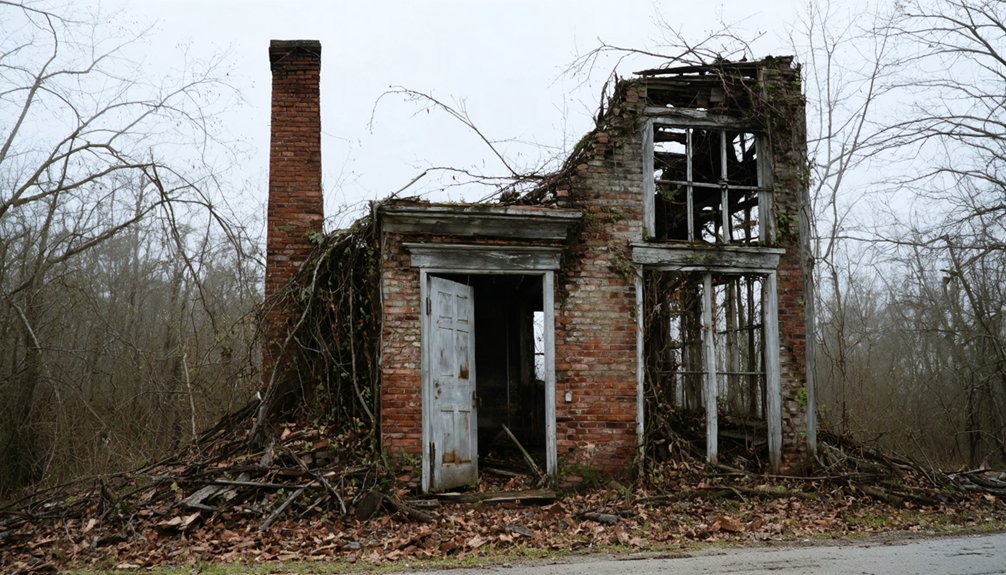You’ll discover Chandler Springs was once a bustling health resort town established in 1835 by the Chandler brothers in Alabama. Known for its seven mineral springs and therapeutic treatments, it flourished as a wellness destination after the Atlanta, Birmingham and Atlantic Railroad arrived in 1909. The town’s decline began with shifting transportation patterns in the mid-20th century, and today nature has reclaimed most of what was once “The Highest and Coolest Resort in Alabama” – though its remarkable story lives on.
Key Takeaways
- Chandler Springs transformed from a thriving 1835 health resort town into a ghost town following major transportation shifts in the mid-19th century.
- The town’s decline began when railroad expansion redirected commerce and tourism to new hubs, effectively isolating the community.
- Poor road infrastructure prevented Chandler Springs from benefiting from the rise of automobiles in the 1920s.
- Once famous for seven mineral springs and therapeutic treatments, the town now exists primarily in community memory rather than physical landmarks.
- Nature has reclaimed most of the former town’s structures, with no official tourism infrastructure remaining for modern visitors.
The Rise of a 19th Century Resort Town
While many Southern resort towns emerged during the Victorian era, Chandler Springs carved out its own unique story in Talladega County, Alabama.
You can trace its roots back to 1835 when the Chandler brothers, including James Chandler, first established their settlement.
Originally known as Mountain Springs, the community grew as families from Georgia and the Carolinas put down roots in this promising land.
Like other areas in Alabama during this period, settlers found reliable water sources through hand-dug wells, which provided essential resources for both families and livestock.
The area later gained prominence as a health destination, with visitors seeking the healing properties of its seven mineral waters, including iron, aluminum, sulfate, and arsenic varieties.
Natural Springs and Healing Waters
You’ll find the natural springs of Chandler Springs rich in iron and sulphur minerals, which early visitors believed possessed remarkable healing properties.
Resort-goers flocked to the area’s bath houses to soak in these therapeutic waters, seeking relief from various ailments through mineral-water treatments.
The springs’ reputation for natural healing drew people from across Alabama to partake in the curative traditions that defined this once-bustling mountain retreat. Today, these springs remain nestled within dense forests and woodlands that create a tranquil environment for visitors.
Situated at 1,177 feet above sea level, the elevated location provided a cool mountain escape for those seeking the springs’ therapeutic benefits.
Mineral Properties and Benefits
Hidden beneath the surface of Chandler Springs lies a remarkable network of mineral-rich waters that have drawn visitors for over 165 years.
You’ll find these pristine waters packed with natural electrolytes like sodium, magnesium, and calcium, offering mineral benefits that go far beyond simple hydration. The springs’ unique composition helps maintain your body’s electrolyte balance while supporting cardiovascular health and muscle function. Dr. Kemp’s treatments attracted people seeking natural remedies from across the nation in the late 1930s.
The waters contain beneficial silica, which can improve your skin and connective tissue health, while the natural blend of phosphorus and calcium strengthens bones. Located within the Talladega National Forest, these springs represent just one of the area’s natural treasures.
You won’t taste any harsh mineral flavors – these waters are smooth and invigorating, thanks to the careful filtering of iron and manganese.
It’s no wonder the local community has long treasured these springs for their exceptional purity and wellness properties.
Resort’s Therapeutic Treatments
As visitors flocked to Chandler Springs during its heyday, the resort’s therapeutic treatments offered a thorough approach to health and wellness.
You’d find yourself immersed in healing spring waters, following prescribed drinking regimens, and breathing in mineral-rich vapors. The resort’s therapeutic techniques targeted everything from rheumatism and respiratory ailments to digestive disorders and nervous conditions.
Beyond the waters themselves, you’d experience a complete healing journey. The resort’s doctors would create personalized treatment plans combining hydrotherapy, rest periods, and dietary guidelines. Like the early aims of humane care institutions, the resort emphasized both treatment and comfort for those seeking help. Similar to modern integrated health care approaches, the facility addressed both physical and mental wellness needs.
You could wander through peaceful gardens, take in the clean mountain air, and participate in gentle exercise programs. The natural environment played a vital role in your recovery, with the serene setting providing both physical and mental restoration.
Spring Water Bath Houses
Natural springs punctuate the landscape of Chandler Springs, though historical records reveal a simpler relationship with these waters than the grand bath houses found in other resort towns.
You won’t find elaborate spas or mythical healing centers here – instead, you’ll discover pristine springs bubbling up from the earth, often disappearing back into the ground after brief surface flows.
Unlike spring myths and local legends that surround other Southern water destinations, Chandler Springs’ waters tell a more modest tale.
The area was initially settled around 1835 when Mordecai and James established the community.
While early settlers certainly used these springs for their daily needs, there’s no evidence of formal bath houses ever being built.
The springs flow through the county’s characteristic red clay soil, which is naturally enriched with lime deposits.
Today, you can still experience these natural springs much as they’ve always been – unspoiled, mineral-rich waters flowing freely through the dense forests of Talladega County.
Life at the Peak of Prosperity
Located in the heart of Talladega County, Alabama, Chandler Springs once thrived around its namesake natural springs, which served as the community’s lifeblood.
During its peak, you’d have found a settlement shaped by the region’s abundant natural resources and high precipitation levels, fostering various agricultural pursuits and potential resource extraction activities.
The community dynamics revolved around the spring waters, with families settling nearby to take advantage of the area’s natural bounty.
While specific population numbers haven’t survived in historical records, you would’ve witnessed a bustling community life centered on economic sustainability through farming and local industry.
The infrastructure, though modest, included essential roads and buildings, with the springs serving as the focal point of development and daily activities.
Transportation and Tourism Impact
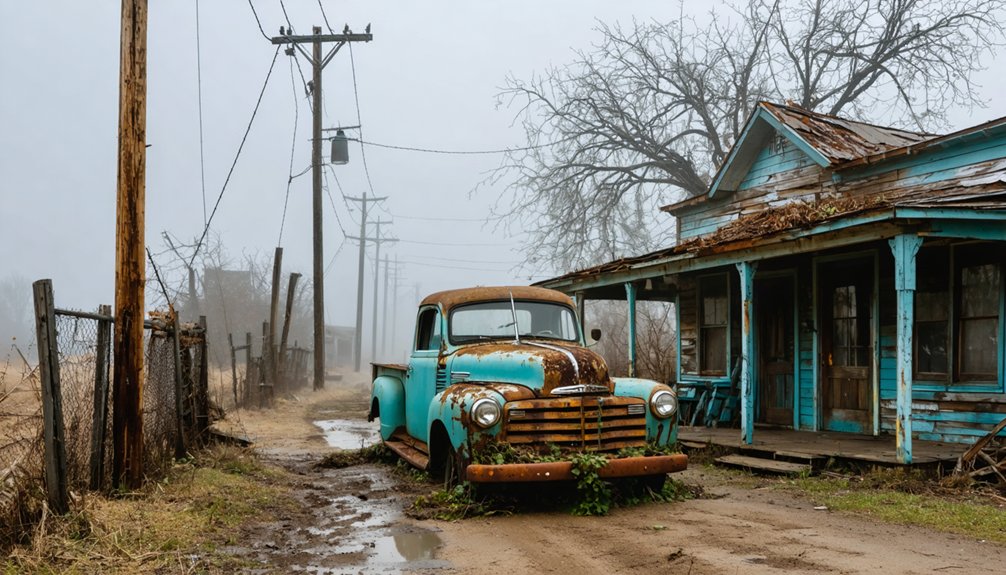
You’ll find that Chandler Springs’ early prosperity stemmed from its convenient railroad access, which brought visitors to the town’s healing mineral springs and resort amenities.
The town’s strategic location along travel routes fostered steady growth through the late 1800s and early 1900s as guests could easily reach the destination from larger cities.
When transportation patterns shifted away from rail travel and newer highways bypassed the area, Chandler Springs gradually lost its tourism appeal and economic significance.
Resort Rail Access
The arrival of the Atlanta, Birmingham and Atlantic Railroad transformed Chandler Springs into a thriving resort destination in 1909, providing direct rail service that would shape the area’s tourism for decades to come.
This railway heritage created a unique tourism synergy, as trains regularly stopped at the resort hotel for meal breaks since the line didn’t include dining cars.
You’ll find it fascinating that the railroad’s presence was essential to the resort’s marketing as “The Highest and Coolest Resort in Alabama.”
The convenient rail access made it easy for visitors from nearby cities like Talladega, just 18 miles away, to enjoy summer cottages and resort amenities.
The strategic partnership between the railroad and resort helped both thrive, with the hotel serving train passengers and the railway delivering a steady stream of tourists.
Growth Through Travel Routes
Beyond the railroad’s influence, Chandler Springs developed an intricate network of travel routes that transformed it into a bustling hub of activity.
You would’ve witnessed the town’s remarkable economic revitalization as these routes connected it to major cities and trading centers throughout Alabama. The improved travel connectivity attracted businesses, tourists, and new residents who were drawn to the area’s natural springs and scenic landscapes.
Local entrepreneurs seized opportunities by establishing inns, restaurants, and shops along these routes, creating a vibrant commercial district.
The town’s strategic location made it an ideal stopover for travelers, while the well-maintained roads guaranteed easy access to emergency services and community facilities.
These travel arteries didn’t just move people – they breathed life into Chandler Springs, fostering both economic growth and cultural exchange.
Decline After Transportation Shifts
While Chandler Springs once thrived as a destination along traditional travel routes, dramatic shifts in transportation during the mid-19th century marked the beginning of its decline.
The arrival of railroads in Alabama fundamentally changed how people and goods moved through the region, creating new economic patterns that bypassed the once-bustling community.
These transportation changes reshaped the area’s destiny in several key ways:
- Railroad expansion redirected commerce and tourism to new rail hubs, leaving Chandler Springs isolated from major transport corridors.
- Poor local roads limited the town’s ability to benefit from the rise of automobiles in the 1920s.
- Freight traffic shifted to more flexible truck routes, bypassing the community’s established trade patterns.
- Lack of infrastructure investment deterred tourism development, as visitors sought more accessible destinations.
The Decline and Abandonment
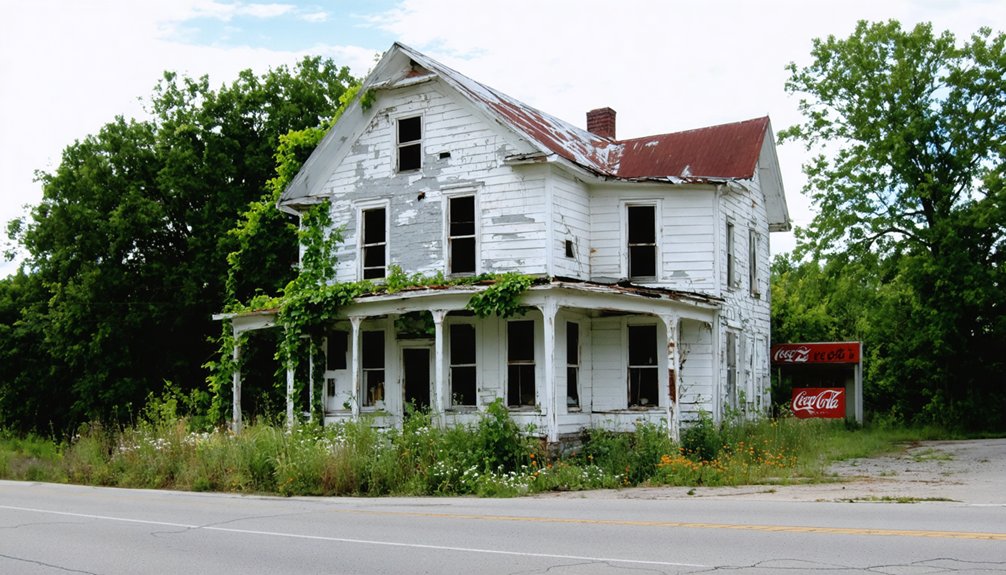
During the mid-twentieth century, Chandler Springs experienced a gradual but devastating decline that ultimately led to its abandonment. The town faced severe economic challenges as traditional industries became obsolete, leaving residents with few employment options.
You’d have seen families who’d lived there for generations forced to seek opportunities elsewhere, leading to widespread community displacement.
The decline wasn’t solely economic – aging infrastructure, limited modern amenities, and changing demographics all played significant roles in the town’s fate.
As more residents left, local businesses shuttered their doors, and community institutions began to disappear. The social fabric that had held Chandler Springs together for so long slowly unraveled, leaving behind empty buildings and quiet streets where a thriving community once stood.
Present-Day Historical Legacy
Today’s visitors to Chandler Springs won’t find the bustling community that once called this place home. Unlike some of Alabama’s more prominent ghost towns, Chandler Springs’ historical significance exists primarily in community memory rather than physical landmarks.
You’ll encounter a landscape where nature has largely reclaimed what humans once built, with few visible reminders of its past.
If you’re interested in exploring this forgotten place, here’s what you should know:
- No official tourism infrastructure exists, so you’ll need to plan a self-guided visit.
- The site lacks protected status, making it vulnerable to further decay.
- Local oral histories provide the main connection to its past.
- Archaeological potential remains largely unexplored, offering opportunities for careful discovery.
Frequently Asked Questions
What Indigenous Tribes Originally Inhabited the Chandler Springs Area Before Settlement?
While you might think only Cherokee heritage dominated the area, both Cherokee and Creek traditions flourished there, with the Creek (Muscogee) people being the primary inhabitants before European settlement began.
Are There Any Documented Paranormal Activities or Ghost Stories From Chandler Springs?
You won’t find documented ghost sightings or haunted locations here – historical records and local sources show no paranormal activity in this former resort town’s peaceful grounds and abandoned structures.
What Happened to the Resort’s Original Furnishings and Equipment After Abandonment?
Like traces vanishing in shifting sands, you’ll find no records of furnishing preservation or equipment disposal. The resort’s contents were simply left to decay through 17 years of abandonment and weather exposure.
Can Visitors Legally Explore the Chandler Springs Site Today?
You’ll need to obtain permission first since legal access isn’t clearly established. Check with local authorities and landowners, following exploration guidelines to protect this historic site’s remaining features.
Were Any Famous Historical Figures Known to Have Stayed at Chandler Springs?
While you’ll hear claims about famous guests and historical visitors at the resort, there’s no verified evidence or documentation of any notable figures having stayed at the springs during its heyday.
References
- https://strangesouthernstories.wordpress.com/2020/12/28/alabama-ghost-town/
- https://www.wwno.org/news/2023-10-31/place-erased-how-a-drowned-alabama-town-still-holds-lessons-60-years-later
- https://digitalalabama.com/alabama-ghost-towns/alabama-ghost-towns/9449
- https://www.anyplaceamerica.com/directory/al/talladega-county-01121/locales/chandler-spring-station-historical–162410/
- https://en.wikipedia.org/wiki/List_of_ghost_towns_in_Alabama
- https://discoverstclair.com/traveling-the-backroads/chandler-mountain/
- https://www.youtube.com/watch?v=UVeIQIYCku8
- https://wbhm.org/2023/place-erased-how-a-drowned-alabama-town-still-holds-lessons-60-years-later/
- http://familytrailsalabama.blogspot.com/2015/07/the-highest-and-coolest-resort-in.html
- https://sites.rootsweb.com/~mikeyspage/chandler.html
